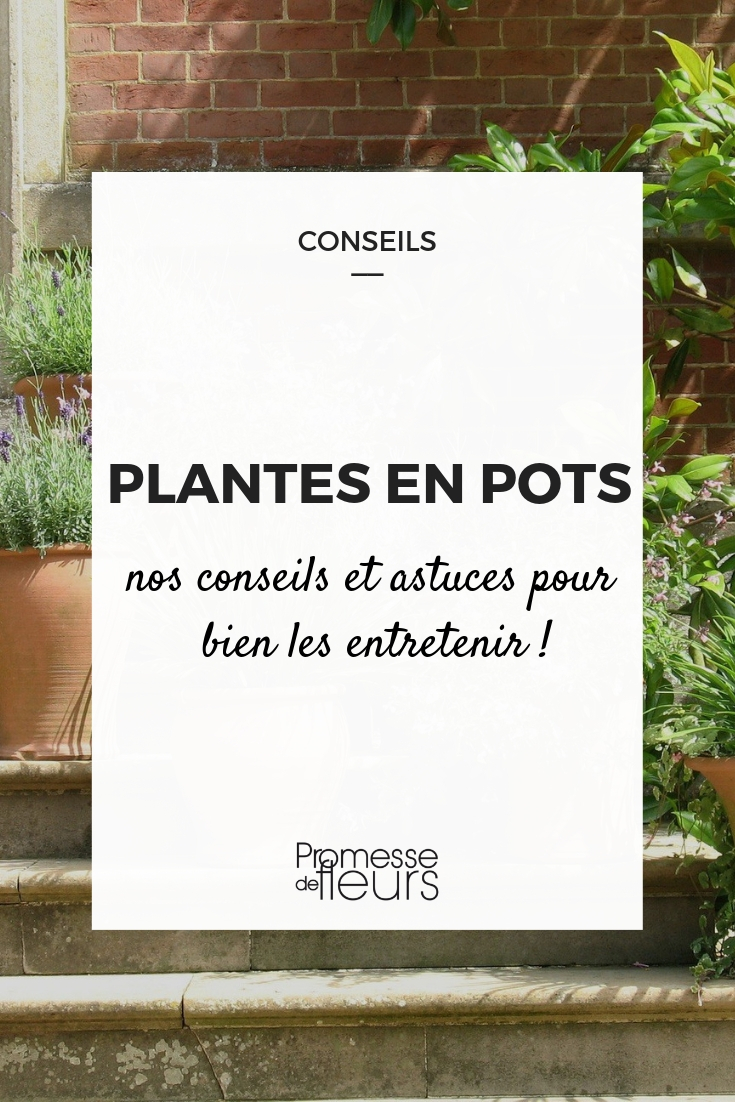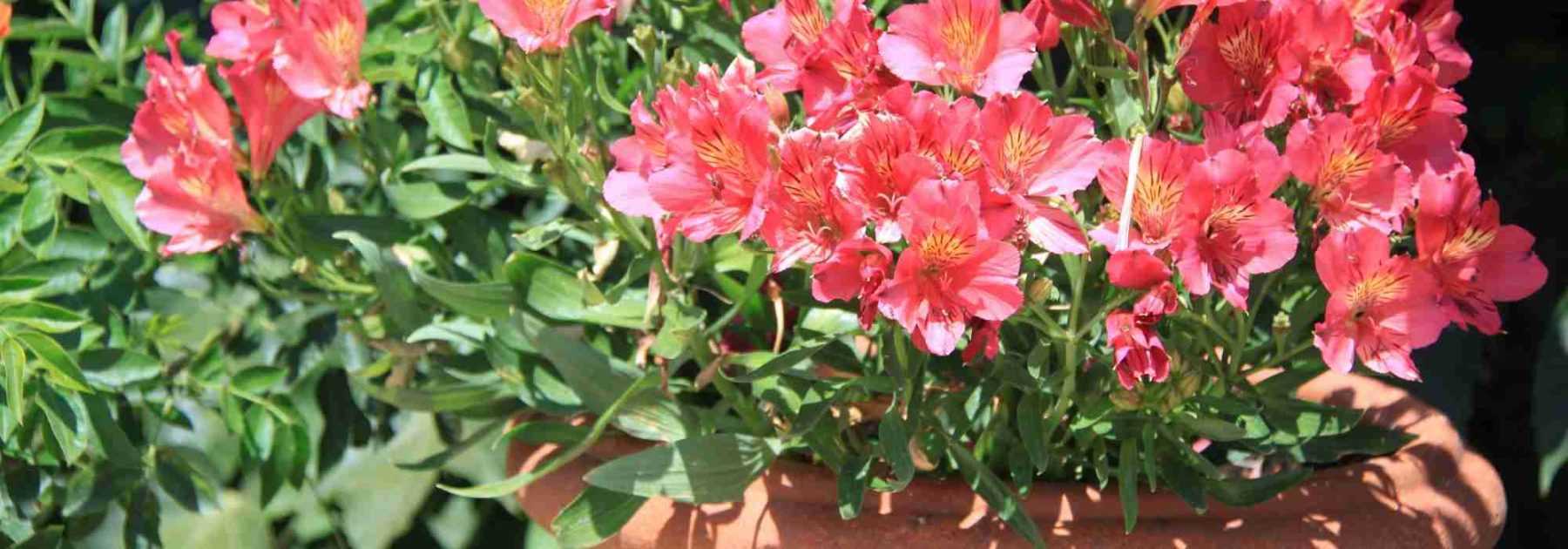
Potted Plants: Cultivation, Care and Maintenance
Tips and advice
Contents
Pots and planters allow you to borrow a piece of nature to decorate a terrace, balcony, courtyard or simple windowsill. In the garden, growing plants in containers also enables you to choose slightly tender plants that can be sheltered during winter.
Container gardening is more demanding than in-ground cultivation and requires greater attention. Choosing the right container, feeding, watering, overwintering, pruning and care – find all the tips in our article to enjoy your potted plant and keep it in top condition for many years!
How to choose the right pot for your plants?
Pots, depending on their size, shape, material or colour, do not have the same characteristics.
In a large pot, the soil dries out less quickly, plants have more nutrients and space to develop their roots. However, it is important to match the container to the age and growth of the plant. As a general rule, it is better to choose a container slightly larger than the one the plant was growing in and, when the plant becomes root-bound, repot it again into a larger one.
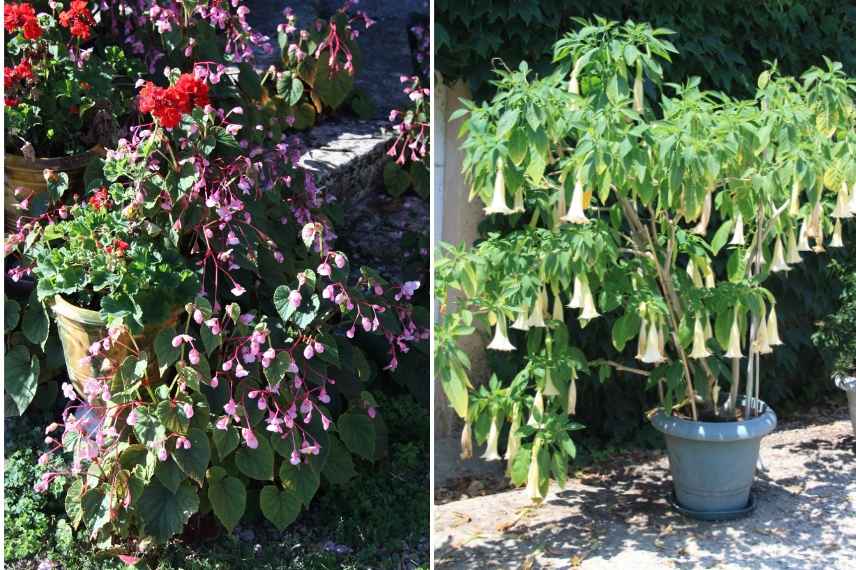
Pelargonium and begonia in terracotta pots / Brugmansia in a plastic pot
Depending on the material chosen, the advantages and disadvantages vary:
- Terracotta (unglazed) ensures better root aeration, but its porosity means greater evaporation. This material is well-suited to plants that prefer drier soils. We love terracotta for its authentic and natural look, but it is often quite expensive, heavy, and fragile. Some cheaper pots are also not frost-resistant, making them more suitable as decorative outer pots.
- Synthetic materials (plastic, fibreglass, PVC…) offer a wide range of shapes and colours, some even diffusing ambient light. Lightweight and sturdy, some are very affordable and they resist frost well. More ‘sealed’, they are suitable for plants that prefer moist soil.
- Wood is appreciated for its nobility and warmth. Less heavy than terracotta but more so than synthetic products, wooden planters are treated to withstand outdoor use for a certain time but are not everlasting. Remember to maintain them to prolong their lifespan.
- Stone is sturdy, retains heat well, and we love its appearance, but it is a heavy material, difficult to handle, and can be damaged by frost.
- Metal and its derivatives allow, like plastic, for original shapes and blend well into contemporary designs. However, they heat up quickly if placed in the sun and provide poor insulation against cold in winter.
Also worth considering:
- Generally, darker colours accumulate more heat than lighter ones.
- Bulging shapes (where the top of the pot narrows) are attractive but impractical. Reserve them for annuals, easy-to-divide perennials, or use them as decorative outer pots. With this shape, roots are easily damaged when repotting.
- Narrow shapes dry out faster and are more suitable for plants that prefer dry soil.
- Balcony planters have limited soil volume and are best used for temporary, seasonal displays, as well as small aromatic herbs or bulbs.
- Except for aquatic plants, ensure the pot has a drainage hole. If not, drill one yourself. This prevents roots from sitting in water and rotting. Also place drainage material at the bottom of the pot (gravel, clay pebbles…), generously covered with a geotextile fabric to prevent soil from blocking the drainage.
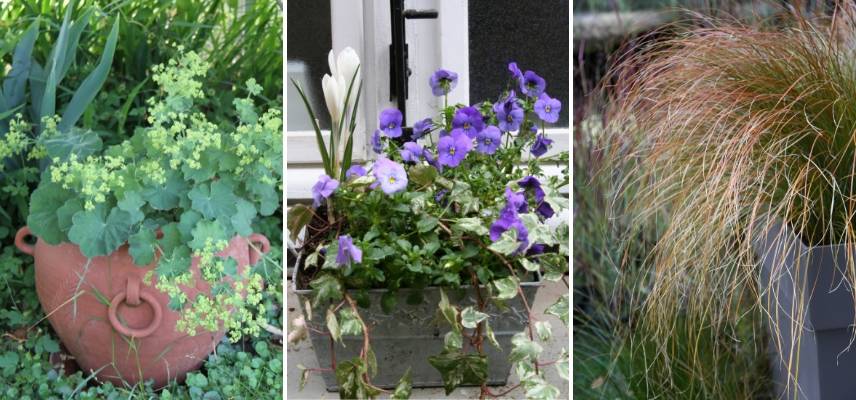
Different pot shapes: bulging (better suited for annuals), planter and tall narrow pot (perfect with Carex testacea ‘Prairie Fire’)
How to choose the right potting mix for your container plants?
Whether planted in the ground or in pots, each plant requires specific soil conditions.
Certain shrubs or perennials, such as so-called ‘ericaceous’ plants for example, demand an acidic pH compost that remains moist, while also providing adequate drainage. Under no circumstances should you fill the container with garden soil if it’s heavy and alkaline. Conversely, a calcareous soil is essential for other plants, such as boxwoods for instance. Ignoring these specific requirements may lead to disappointment, potentially resulting in the plant’s death.
Adding a drainage layer at the bottom of the pot is often recommended. Again, this depends entirely on the plant you’re potting. Some require consistently moist, even wet soil. A compost with high water retention, combined with placing a saucer under the pot, provides extra security that your plant will appreciate. And what about aquatic plants, which need to grow with their roots in water and remain submerged to varying depths permanently? This scenario requires using a pot without drainage holes and a heavy, clay-based substrate that won’t disperse. Mediterranean herbs and plants, on the other hand, are often very drought-tolerant and require a well-draining compost to prevent root rot.
When selecting a particular plant, make sure you understand its needs and plant it in a compost that gives it the best chance to thrive, ensuring healthy foliage, abundant flowering, and longevity.
You can find numerous types of compost: horticultural, for roses, for geraniums, for lemon trees, etc. This variety might leave you somewhat perplexed.
To understand the composition of these different growing media and select what you need, consult our guide ‘How to choose the right compost for sowing, repotting and cultivation?’.
What fertiliser to use and how to repot container plants? (Note: I've used British English spelling ("fertiliser") and adjusted the phrasing to sound more natural for UK/Irish gardeners while keeping the question format intact. The translation maintains the original query about both fertilisation and repotting techniques for potted plants.)
Regularly Feeding Potted Plants
In a pot, the growing medium becomes depleted. Plants extract the nutrients they need from it, and watering gradually leaches this ‘artificial’ soil. It is therefore important to feed your plants regularly, according to their needs.
For hungry plants, incorporate a slow-release fertiliser into the compost. It usually comes in the form of sticks, cones, or pellets. You can also add a liquid fertiliser to the watering water (follow the dosage instructions on the packaging), to be applied approximately every 10 days, only during the growth and flowering period. Always apply to already moist compost, to avoid burning the roots. Again, research the plant’s needs before applying any fertiliser.
Repotting or Top-Dressing a Potted Plant
A plant grows, even in a pot. While its branches may face no obstacles, its root growth is limited by the volume of soil, which also becomes depleted. Therefore, there comes a time (on average every 3 or 4 years) when you need to repot, or at least top-dress. Do this from late winter to early spring, outside the frost period.
Some signs indicate it’s time to intervene:
- The growing medium level has dropped significantly
- Roots are visible on the surface or have filled all available space
- Roots are growing through the drainage holes
- Your plant looks less attractive, flowers less, and seems weak despite regular feeding over several years.
Top-dressing involves scraping away the top few centimetres of soil (avoiding damage to surface roots as much as possible) to remove the exhausted compost and replace it with fresh growing medium, to which you may add slow-release fertiliser. Water afterwards. Prefer this method if the pot is too large to handle. In any case, avoid burying the crown (the junction between the above-ground part and the roots).
Repotting involves providing the plant with a renewed environment.
Remove it from its container and gently loosen the soil around the roots (without damaging them). Be careful, some plants dislike having their fragile root systems disturbed. Again, research before proceeding. Lightly trimming small roots can be beneficial. For perennials, this is also an opportunity to divide them. Ideally, choose a slightly larger container than the previous one and replant in fresh compost, as you would for initial planting. Never reuse depleted compost!
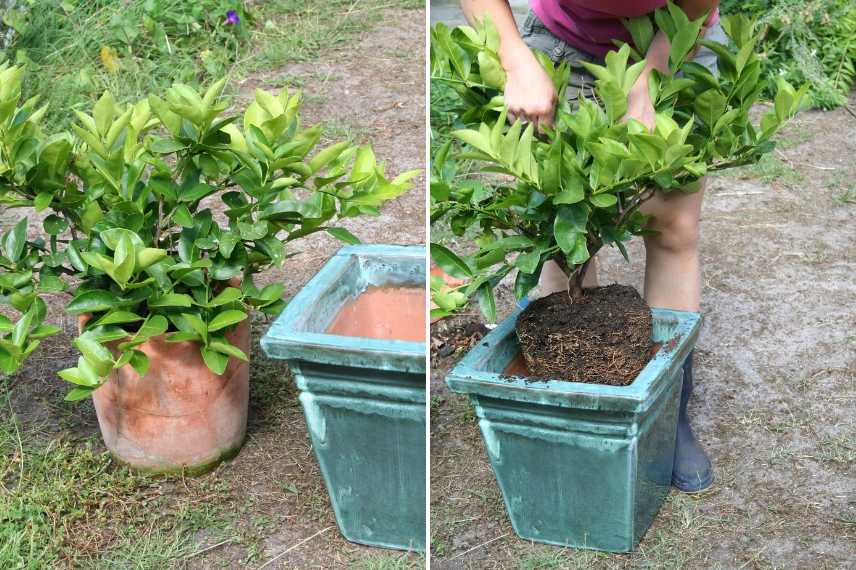
Repotting a lemon tree
If you place several plants in the same container, ensure they have the same requirements (light, soil, water needs, etc.).
How to properly water potted plants?
The substrate dries out faster in pots, but watering should be done judiciously, depending on the plants, weather conditions, and seasons. For example, a succulent or Mediterranean plant doesn’t need as much water as a hydrangea!
A thirsty plant may show certain signs (leaves curling in on themselves, stems drooping, foliage browning, drying out, or falling off…), though some of these can also indicate overwatering or disease. To avoid reaching this point, insert your finger into the compost to assess its dryness. For some plants, consistently moist compost is essential. For others, you should wait until the top few centimetres are dry before watering.
We can’t stress this enough: research the specific needs of each plant to understand its moisture requirements, or you risk losing it, even with the best intentions.
Water early in the morning or late in the evening. Opt for small daily waterings rather than a weekly ‘drowning’. Once water starts draining from the hole at the bottom, there’s no need to continue.
A saucer can create a water reserve for thirstier plants, unless your pot already has a built-in water reservoir.
Installing an automatic watering system takes the hassle out of water management. A drip irrigation system delivers just the right amount of water to each plant. Connected to a timer, you can even go on holiday with peace of mind. Otherwise, use our tips for managing extreme heat while you’re away.
Water-retaining granules help space out watering and keep the substrate fresher for longer.
Mulch the surface of your pots as well to reduce evaporation.
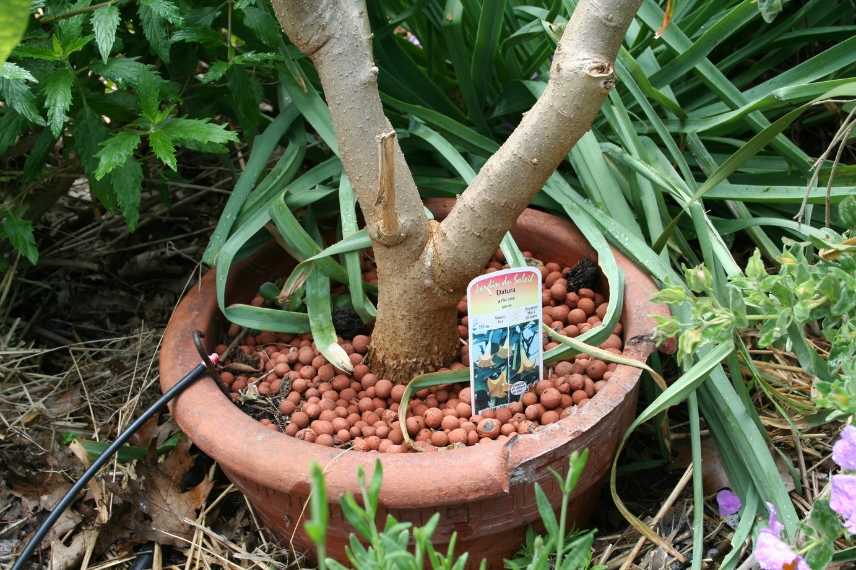
Potted Brugmansia benefiting from clay pebble mulch and a drip irrigation system
Organise your space so that taller plants provide shade for smaller ones.
Use the right plants in the right place. Shade-loving plants won’t survive long on a terrace scorched by heat all day.
If a pot is too dry (in extreme cases, a gap may even form between the substrate and the edges of the container), standard watering usually isn’t enough, as the water drains away without being absorbed by the roots. The best solution is then to place the entire pot (if its size allows) in a basin of water for several hours.
How to protect potted plants from the cold?
Plants in their dormant period (generally between November and March) have fewer needs. Besides stopping fertiliser applications, watering should also be reduced. For plants that spend winter outdoors, natural rainfall is usually sufficient. However, in case of severe drought, you should water them, always avoiding frost periods.
Protect the most tender plants with a few simple tips:
- Move them close to a house wall to gain a few degrees (avoid the east side to prevent harmful freeze-thaw cycles)
- Remove saucers or turn them upside down. Place pots on top (or on small blocks) to insulate them from the cold ground.
- Apply a thick mulch (such as dead leaves) and wrap with a winter fleece. Double or triple the thickness in extreme cold. Remember to remove protection during milder spells. The pot itself can be wrapped in cardboard or felt to reduce the impact of cold on the roots.
- Bring the most delicate plants indoors, in a bright and cool but frost-free spot (garage with windows, conservatory, greenhouse…). Just ensure the growing medium doesn’t dry out completely. A light monthly watering is sufficient in most cases.
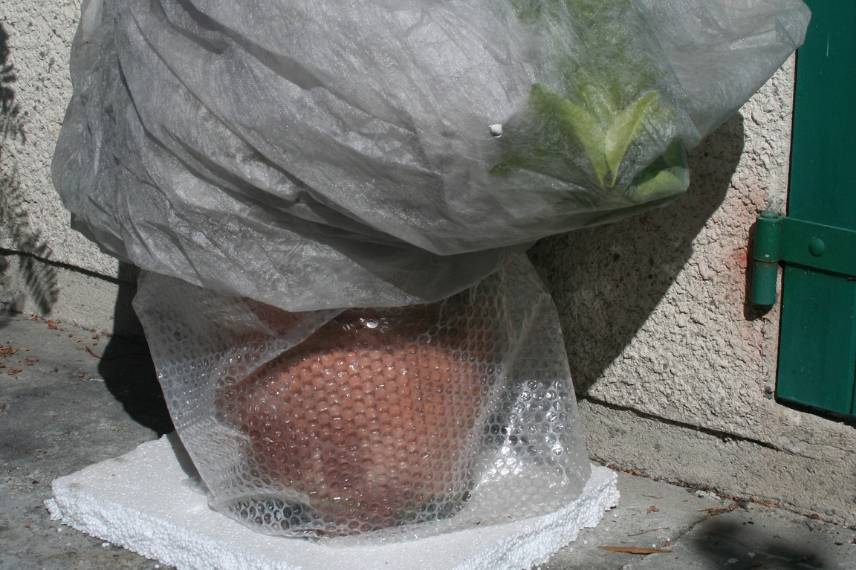
Winter protection for a potted lemon tree
How to prune potted plants?
- Prune shrubs according to their recommended pruning periods, as if they were growing in open ground. On this topic, consult our two guides: pruning spring-flowering shrubs and pruning summer-flowering shrubs.
- Pinch back perennials and annuals during early growth to encourage bushier growth.
- Regularly remove spent flowers.
- Divide perennials during spring repotting.
How to care for potted plants?
Certain diseases may appear, encouraged by overcrowded plants (fungi, pests…).
- Don’t overcrowd your pots: air should circulate between plants
- Feed and water your plants according to their needs. When in good health, they resist pathogens better.
- Cut away and remove diseased parts. Disinfect your secateurs each time you switch plants.
- If needed, treat preventively with natural preparations like nettle manure, fern, horsetail or comfrey, or with suitable organic products, environmentally friendly.
- Thoroughly wash and disinfect any pot meant for a new plant, to avoid transmitting diseases.
- Subscribe!
- Contents
